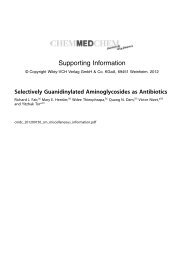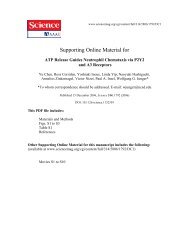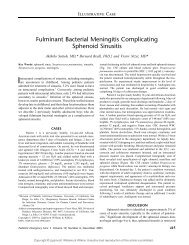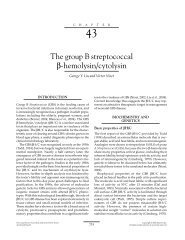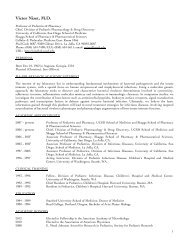BACTERIAL SEPSIS AND MENINGITIS - Nizet Laboratory at UCSD
BACTERIAL SEPSIS AND MENINGITIS - Nizet Laboratory at UCSD
BACTERIAL SEPSIS AND MENINGITIS - Nizet Laboratory at UCSD
Create successful ePaper yourself
Turn your PDF publications into a flip-book with our unique Google optimized e-Paper software.
lumbar puncture should be considered only for infants in<br />
whom meningitis is a possible diagnosis.<br />
Some investig<strong>at</strong>ors suggest th<strong>at</strong> too many healthy term<br />
infants have a diagnostic evalu<strong>at</strong>ion for sepsis, including<br />
lumbar puncture, based solely on m<strong>at</strong>ernal risk fe<strong>at</strong>ures<br />
and th<strong>at</strong> lumbar puncture rarely provides clinically useful<br />
inform<strong>at</strong>ion. Other investig<strong>at</strong>ors have questioned the role<br />
of lumbar puncture on admission in the prem<strong>at</strong>ure infant<br />
with respir<strong>at</strong>ory distress and found th<strong>at</strong> the yield of the<br />
procedure is very low [546–548]. Of more than 1700<br />
infants with respir<strong>at</strong>ory distress syndrome evalu<strong>at</strong>ed for<br />
meningitis, bacterial p<strong>at</strong>hogens were identified in CSF<br />
of only 4. Three of the four infants with meningitis were<br />
bacteremic with the same p<strong>at</strong>hogen [548].<br />
A large, retrospective study assessed the value of lumbar<br />
puncture in the evalu<strong>at</strong>ion of suspected sepsis during<br />
the first week of life and found th<strong>at</strong> bacteria were isol<strong>at</strong>ed<br />
from 9 of 728 CSF specimens, but only one infant was<br />
believed to have bacterial meningitis [549]. Fielkow and<br />
colleagues [550] found no cases of meningitis among<br />
284 healthy-appearing infants who had lumbar puncture<br />
performed because of m<strong>at</strong>ernal risk factors, whereas<br />
2.5% of 799 neon<strong>at</strong>es with clinical signs of sepsis had<br />
meningitis regardless of m<strong>at</strong>ernal risk factors. The value<br />
of lumbar puncture has been established for infants with<br />
clinical signs of sepsis, but lumbar puncture performed<br />
because of m<strong>at</strong>ernal risk fe<strong>at</strong>ures in a healthy-appearing<br />
neon<strong>at</strong>e is less likely to be useful.<br />
The consider<strong>at</strong>ions are quite different for very low<br />
birth weight neon<strong>at</strong>es (400 to- 1500 g), as documented<br />
in a study by Stoll and colleagues [545] performed<br />
through NICHD Neon<strong>at</strong>al Research Network. One third<br />
(45 of 134) of these high-risk neon<strong>at</strong>es with meningitis<br />
has neg<strong>at</strong>ive blood cultures. Lower gest<strong>at</strong>ional age and<br />
prior sepsis were important risk factors for development<br />
of meningitis, which carried a significant risk of mortality<br />
compared with uninfected infants (23% versus 2%).<br />
These results indic<strong>at</strong>e the critical importance of lumbar<br />
puncture and suggest th<strong>at</strong> meningitis may be significantly<br />
underdiagnosed in very low birth weight infants [545].<br />
Method of Lumbar Puncture<br />
Lumbar puncture is more difficult to perform in neon<strong>at</strong>es<br />
than in older children or adults; traum<strong>at</strong>ic lumbar punctures<br />
resulting in blood in CSF are more frequent, and<br />
care must be taken in the infant who is in respir<strong>at</strong>ory distress.<br />
Gleason and colleagues [551] suggested th<strong>at</strong> the<br />
procedure be performed with the infant in the upright<br />
position or, if performed in the flexed position, be modified<br />
with neck extension. Pinheiro and associ<strong>at</strong>es [552]<br />
evalu<strong>at</strong>ed the role of locally administered lidocaine before<br />
lumbar puncture and found th<strong>at</strong> the local anesthesia<br />
decreased the degree of struggling of the infant. Other<br />
investig<strong>at</strong>ors concluded, however, th<strong>at</strong> local anesthesia<br />
failed to influence physiologic changes in the neon<strong>at</strong>e<br />
undergoing lumbar puncture [553]. Fiser and colleagues<br />
[554] suggested th<strong>at</strong> the administr<strong>at</strong>ion of oxygen before<br />
lumbar puncture prevents most hypoxemia resulting from<br />
this procedure in infants.<br />
The physician can choose to withhold or delay lumbar<br />
puncture in some infants who would be placed <strong>at</strong> risk for<br />
CHAPTER 6 Bacterial Sepsis and Meningitis<br />
255<br />
cardiac or respir<strong>at</strong>ory compromise by the procedure.<br />
Weisman and colleagues [555] observed th<strong>at</strong> transient<br />
hypoxemia occurred during lumbar puncture performed<br />
in the l<strong>at</strong>eral position (i.e., left side with hips flexed to<br />
place knees to chest), but occurred less frequently when<br />
the infant was in a sitting position or modified l<strong>at</strong>eral<br />
position (i.e., left side with hips flexed to 90 degrees).<br />
Reasons for withholding lumbar puncture in older children,<br />
such as signs of increased intracranial pressure,<br />
signs of a bleeding disorder, and infection in the area th<strong>at</strong><br />
the needle would traverse to obtain CSF, are less likely to<br />
be concerns in the neon<strong>at</strong>e.<br />
Ventricular puncture should be considered in an infant<br />
with meningitis who does not respond clinically or microbiologically<br />
to antimicrobial therapy because of ventriculitis,<br />
especially with obstruction between the ventricles<br />
and lumbar CSF. Ventriculitis is diagnosed on the basis<br />
of elev<strong>at</strong>ed white blood cell count (>100 cells/mm 3 ) or<br />
identific<strong>at</strong>ion of bacteria by culture, Gram stain, or antigen<br />
detection. Ventricular puncture is a potentially hazardous<br />
procedure and should be performed only by a<br />
physician who is an expert in the technique.<br />
If a Lumbar Puncture Is Not Performed<br />
Is it sufficient to culture only blood and urine for the<br />
diagnosis of neon<strong>at</strong>al bacterial meningitis? Visser and<br />
Hall [556] showed th<strong>at</strong> the blood culture was sterile when<br />
CSF yielded a p<strong>at</strong>hogen in 6 (15%) of 39 infants with bacterial<br />
meningitis. Franco and colleagues [557] reported<br />
th<strong>at</strong> in 26 neon<strong>at</strong>es with bacterial meningitis, only 13<br />
had a positive blood culture. In surveys from two large<br />
d<strong>at</strong>abases—NICUs managed by the Pedi<strong>at</strong>rix Medical<br />
Group [558] and NICHD Neon<strong>at</strong>al Research Network<br />
[545]—results were similar: One third of infants <strong>at</strong> 34 or<br />
more weeks estim<strong>at</strong>ed gest<strong>at</strong>ion with meningitis and one<br />
third of very low birth weight neon<strong>at</strong>es with meningitis<br />
had neg<strong>at</strong>ive blood cultures. A significant number of<br />
infants with meningitis do not have this diagnosis established<br />
unless lumbar puncture is performed.<br />
Ideally, lumbar puncture should be performed before<br />
the initi<strong>at</strong>ion of antimicrobial therapy, but there are altern<strong>at</strong>ive<br />
str<strong>at</strong>egies for infants who may not toler<strong>at</strong>e the procedure.<br />
If the physician believes th<strong>at</strong> lumbar puncture<br />
would endanger the infant with presumed sepsis and meningitis,<br />
therapy should be initi<strong>at</strong>ed after blood (and urine<br />
for l<strong>at</strong>e-onset illness) is obtained for culture. After the<br />
infant is stabilized, lumbar puncture should be performed.<br />
Even several days after the start of antibiotic therapy, CSF<br />
pleocytosis and abnormal CSF chemistry assays usually<br />
should identify the presence or absence of an inflamm<strong>at</strong>ory<br />
reaction, although CSF culture may be sterile.<br />
Examin<strong>at</strong>ion of Cerebrospinal Fluid<br />
The cell content and chemistry of CSF of healthy newborn<br />
infants differ from those of older infants, children,<br />
and adults (Table 6–16). The values vary widely during<br />
the first weeks of life, and the normal range must be considered<br />
in evalu<strong>at</strong>ion of CSF in infants suspected to have<br />
meningitis [559–568]. The cell content in CSF of a neon<strong>at</strong>e<br />
is higher than in older infants. Polymorphonuclear<br />
leukocytes often are present in CSF of normal newborns,



